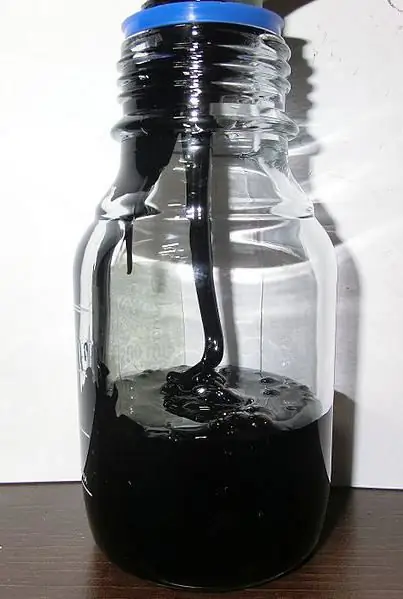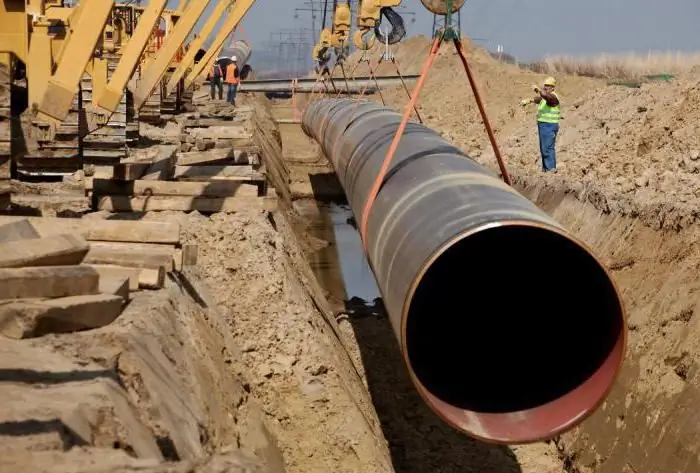2025 Author: Howard Calhoun | [email protected]. Last modified: 2025-01-24 13:10:29
"Druzhba" (main oil pipeline) is Europe's largest network for the delivery of oil to consumers. It's a fairly old but reliable system. Under Soviet rule, there was such a body, the CMEA (Council for Mutual Economic Assistance). It was an intergovernmental organization dealing with economic issues arising from the interaction of the Warsaw Pact countries. At the CMEA session in 1958, it was decided to build such an object as "Druzhba" (oil pipeline), with the aim of supplying oil to the socialist countries of Europe.
The process took 4 years (1960-1964). Some branches were built earlier, and in 1962 Czechoslovakia received the first oil. Later, from 1968 to 1974, due to the increase in oil supplies, a second line was built - "Druzhba -2".

Construction Features
The construction of the Druzhba oil pipeline clearly showed the close cooperation and mutual economic integration of the countries of the socialist camp. The fact is that the pipes for the project were made by the Soviet Union, Czechoslovakia was engaged in fittings, all pumps at the distillation stations were manufactured by the GDR (German quality!), And Hungaryresponsible for the automation of communication equipment.
The purpose of building the Druzhba oil pipeline
"Friendship" (oil pipeline), in fact, was a reflection of the foreign policy of the USSR in those years. Its main feature was assistance to the fraternal socialist countries. In those years, they helped the "brothers" with everything they could. Often for a nominal fee or completely free.
- First target. Strengthen economic friendship between the countries of the eastern Warsaw bloc. Therefore, the oil pipeline system was called "Friendship".
- Second goal. Politics is politics, but economics is economics. Without Soviet oil, it was difficult for the socialist countries of Eastern Europe to survive, develop production and implement social programs.
It was unprofitable and dangerous to take oil by tankers from the capitalists. What if you like it, and what if the West offers preferential terms in order to change regimes? The Union did not encourage and did not tolerate such things. There were examples. The Yugoslav leader, Marshal Josip Broz Tito, carried out some reforms, allowed private business with reservations, and Yugoslavia was immediately equated with a capitalist country, and the marshal was declared a renegade.
During the construction of this grandiose object, both the political and economic goals of the project organizers coincided. The construction of the Druzhba oil pipeline was dictated not only by the political situation, but also by vital necessity.

Where is Russian oil going
Today there is no Soviet Union, noCzechoslovakia, no GDR. History is changing, and the "Druzhba" (oil pipeline) is regularly fulfilling its function: it supplies oil from Russia to the countries of Eastern and Western Europe.
Deliveries are carried out from Tatarstan (Russia) through Ukraine and Belarus to Poland, the Czech Republic, Slovakia, Hungary and Germany. Most of the oil today goes through Belarus, as there are problems with the Ukrainian side, but more on them below.

Druzhba oil pipeline, Bryansk
The network of main oil pipelines "Druzhba" is part of the structure of the Ministry of Natural Resources and Ecology of the Russian Federation. JSC "Main oil pipelines" Druzhba "has its head office in Bryansk. This is due to the fact that the Bryansk region has a unique geographical position. Some of its areas border on Ukraine, while others border on Belarus. The main branch goes from Samara to Bryansk, and then to Mozyr (Belarus) In Mozyr, the system is divided into two important branches: northern (Belarusian) and southern (Ukrainian), so it is convenient to operate the oil pipeline from Bryansk.

Ukrainian branch of the Druzhba oil pipeline
As already mentioned above, in Belarusian Mozyr the system is divided into two branches. The southern Ukrainian part of the pipeline runs from Mozyr to the city of Brody (Ukraine) and further through Galicia and Transcarpathia to Europe. This route is operated by the Ukrainian company UkrTransNafta.
The state of the Druzhba oil pipeline in Ukraine today
The Druzhba oil pipeline in Ukraine is not fully functional today, and therefore Russia is forced to look for workarounds for oil transit to Europe. Plus, UkrTransNafta announced its intention to terminate the 1995 agreement with Russia on the operation of this facility. This is all connected with the poor domestic political situation in Ukraine and the complication of diplomatic relations with Russia.

Accidents at the Druzhba oil pipeline
At the end of the topic, let's talk a little about the accidents at the Druzhba oil pipeline. No one is immune from man-made disasters, so readers will be interested to know how things were with this object.
There were oil leaks. Not critical, not causing catastrophic consequences, but there were. In the Ukrainian section, oil leaks arose due to illegal tapping into a pipe. One of the most notorious cases occurred in July 2012 in Transcarpathia, in the Mukachevo region. Then half a ton of oil spilled into the reclamation canal.
There were also curious situations at first glance. But as a result of such curiosities, there were serious breakdowns in the oil pipeline system. The situation that took place in October 2012 received a great response. Station operators in the Slovak and Czech sections noticed incorrect operation of the devices. Later it turned out that condoms and rubber nipples had entered the system in large quantities. And the pipe got clogged in Ukraine.
A little later, the units at the Hungarian control station were damaged in the same way. ATsocial networks, many wits had fun from the heart. But there was no reason to be happy. Everything is simply banal. Someone crashed into the pipe, stole oil in large quantities, and threw rubber products into the system to confuse meters "downstream" of the oil river.
Recommended:
Oil is a mineral. Oil deposits. Oil production

Oil is one of the world's most important minerals (hydrocarbon fuel). It is a raw material for the production of fuels, lubricants and other materials
How much was the dollar in the USSR? How did the dollar change during the Soviet era?

During the entire second half of the twentieth century, the dollar in the USSR cost less than one ruble, and only a few citizens had it, and then in a limited amount, necessary for traveling abroad or in other exceptional cases
"Object 279". "Object 279" - Soviet experimental supertank: description

In 1956, the USSR Ministry of Defense presented performance characteristics for a new tank. There were three projects, of which "Object 279" is the most ambitious. It was a completely new tank, created for combat in conditions after a nuclear strike
Gas pipeline to Crimea. "Krasnodar Territory - Crimea" - the main gas pipeline with a length of 400 km

The gas pipeline to Crimea was commissioned in December 2016. Its construction took place at an accelerated pace in order to solve the main problem of the Crimean gas transportation system: the lack of own gas to fully supply the peninsula due to increased consumption
How is oil produced? Where is oil produced? Oil price

Currently, it is impossible to imagine the modern world without oil. It is the main source of fuel for various transport, raw materials for the production of various consumer goods, medicines and other things. How is oil produced?

